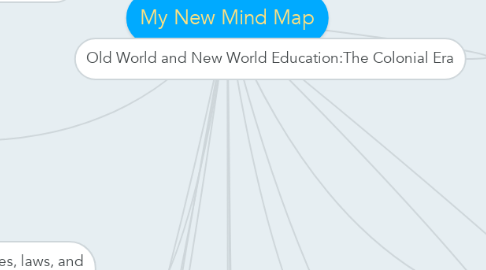My New Mind Map
by Amy Fennell


1. Transmission of Knowledge- How the curriculum is taught, What is being taught, and Who benefits from it...
2. Pedagogy- the discipline that deals with the theory and practice of education; it thus concerns the study of how best to teach. Spanning a broad range of practice, its aims range from furthering liberal education to the narrower specifics of vocational education.
3. Curriculum- (humanist) traditionally this curriculum focused on the Western heritage as the basis for intellectual development, although some who support this type of curriculum argue that the liberal arts need not focus exclusively on the Western tradition.
4. Governance Size and Degree of Centralization, Student Composition, Degree of "Openness", Private Schools, International Comparison, France, The Former Soviet Union, Japan, Germany, Finland, School Processes and School Cultures, The Nature of Teaching, Contridictions of Reform, Magnet Schools: Structured for Excellence,
5. The Structure of U.S. Education
6. Schools as Organizations and Teacher Professionalization
7. An integration of all known principles, laws, and information pertaining to a specific area of study. It allows one to see past the visible and obvious and examine the hidden structure. Theoretical pictures of society are seldom crystal clear or easy in to understand. There is little hope that people can create a productive and just society. It gives one the intellectual scaffolding from which to hang empirical findings.
8. Sociology of Education
8.1. 5 Effects of schooling on individuals that have the greatest impact on students
8.1.1. Employment, gender, teacher behavior, tracking and education mobility
9. Understanding the History of U.S. Education: Different Historical Interpretations
9.1. Democratic liberals believed that education involves the progressive evolution of a school system committed to providing equality of opportunity for all. More students from diverse backgrounds went to school for longer periods of times, the goal of education became more diverse. The evolution of the nation's schools has been a flawed. The Democratic-liberals believe that the educational system must continue to move closer to each, without sacrificing one or the other too dramatically.
10. The Age of Reform: The Rise of the Common School
11. Old World and New World Education:The Colonial Era
12. History of U.S Education
12.1. Education for Women and African-Americans traditionally the role of a woman was a homemaker and the man was the provider. By the 1820's this changed. Women became dedicated to education and a few opened schools. Higher education for women did not remain the exclusive domain of Eastern reformers. Benjamin Roberts filed a legal suit for a requirement that his daughter attend a segregated school. Eventually leading to African-Americans establishing their own facilities.
13. Sociology Perspectives
14. Philosophy of Education
15. Schools as Organizations
16. Curriculum and Pedagogy
17. Equality of Opportunity
18. Educational Inequality
19. Educational Reform and School Improvement
20. Effective Teachers
21. Federal Involvement in Education
22. No Child Left Behind
23. School Choice, Charter Schools and Tuition Vouchers
24. Genetic Differences & Cultural Differences...Genetics is the most controversial student-centered explanation. The argument that unequal educational performance by working-class and non-white students is due to genetic differences in intelligence which was offered by psychologist Arthur Jensen.
25. Explanations of Educational Inequality
26. Equality of Opportunity and Educational Outcome
26.1. Class-class is directly related to achievement and to educational attainment there is a direct correlation between parental income and children's performance on tests.
26.1.1. Race-as individuals race has a direct impact on how much education he or she is likely to achieve.
26.1.1.1. Gender-though women are often rated as being better students than men, in the past they were less likely to attain the same level of education.
27. Educational Reaction and Reform and the Standards Era: 1980s-2012
28. The Post War II Equity Era: 1945-1980
29. Urbanization and the Progressive Impetus
30. My Foundations of Education
31. Politics of Education
31.1. Intellectual-to teach the basic cognitive skills such as reading, writing and math; to transmit specific knowledge and to help students acquire higher order thinking skills such as analysis, evaluation and synthesis.
31.2. Political- to inculcate allegiance to the existing political order; to prepare citizens who will participate in this political order; to help assimilate diverse cultural groups into a common political order and teach children the basic laws of the society.
31.2.1. 4 Purposes of Education!!

